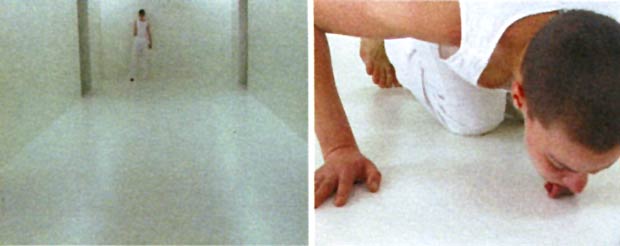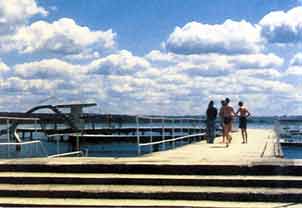|
|
|
| |
|||||
|
|
The Baltic Times Contemporary Art from Estonia, Lithuania and Latvia April 13 – May 23, 2002 |
||||
| |
|||||
|
 Ene-Liis Semper, "Licked Room", 2000 |
||||
| |
|||||
|
Artists
|
|||||
| |
|||||
| Opening 12 April, 7 pm Opening by Dr. Herta Arnold, Office of the Tyrolean Provincial Government, Department for Culture Branka Stipancic and Tihomir Milovac, MSU – Museum of Contemporary Art Zagreb, will speak about the exhibition |
|||||
| |
|||||
| "The Baltic Times" is the name of an
English-language weekly paper that appears in the Baltic countries. The
exhibition curated by Tihomir Milovac und Branka Stipancic (MSU /
Museum of Contemporary Art Zagreb) features works that artists from
these countries have created over the last six years. The Innsbruck
presentation of "The Baltic Times" is a slightly modified version of
the Zagreb exhibition (May/June 2001). Some recently created work was
added, while others were eliminated due to their dimensions that did
not fit the space. Ilmars Blumbergs/ Viesturs Kairišs and
Laila Pakalnina were artists who were specially invited to participate
in the Innsbruck show.
In the post-1989 years,
radical changes took place within the Baltic countries with regard to
both the artistic positions and the general understanding of art. There
emerged an active young art scene that reflected on the artistic ideas
and manifestations from the west but at the same time developed its own
new expressions. "Following the tyranny of the imposed privacy" (Helena
Demakova) interest turned outward, to all realms of public life. In the
process completely new and different tensions and conflicts, fears and
expectations surfaced.
ATG (Academic Training Group) (LT) works with the theme of (self-) representation, one of the motives of "post-Eastern discourse". The issue they deal with is the image of the "other" and the questionable production of national identities. In a slide installation they present stereotype images for the "others", stylized and also aggressive multiculturalism. With "Welcome"(1997), a doormat that is adorned with a text in warped English, they refer to their own eccentric situation from the pose of the "country bumpkin". Ilmars
Blumbergs/Viesturs Kairišs (LV), both film and
theatre directors, showed their film "Magic Flute" (2001) for the first
time at the Venice Biennial, 2001. In reserved, oppressing imagery, the
film shows how the most destitute are buried in Riga – not in a
cemetery but in a wooded area to which the dead are brought in a
rickety delivery van. The film transforms this depressing situation
into a moving scene full of pathos. Here in addition to parts of a
stage set the entire choir of the Magic Flute performance of the
Latvian National Opera appears in full, theatrical costume between the
grave mounds. For the dead who were never able to come into contact
with the opera, Mozart's music resounds as a dirge. The videos of Kai Kaljo (EE) could be described in terms of "video poetry". In "A Loveletter to myself" (1998) she transforms her studio, a non-descript place, into a poetic room in which the easel, the windows, the cigarette smoke and the soap bubbles relate with the sunlight shining into the room in a reflecting interplay where the levels of reality are shifted. In the video "A Loser" (1997) she once again takes her studio as a stage on which she herself appears to draw an ironic-grotesque image of the position of the artist in society, with Kalio uses the techniques of sitcom in a manipulative way. Ly Lestberg
(EE) deals with sexual identities, especially where biological and
social norms come into conflict with inner-psychic interpretation. Gintaras Makarevicius (LT) explores the relation between reality and illusion with a view to integrating the audience into his actionist dramaturgy. "For the Deconstruction of Attention" (1997) consists of a series of round mirrors that can be made to rotate by means of movement sensors and thus seem to trigger off the dissolution of the speculative identity of the onlookers (in the Lacanian sense). Deimantas Narkevicius (LT) takes up the tradition of avantgarde culture where it clashes with everyday social discourses. He is interested in the perception of history and how it changes through ideological interpretations. His film "Energy Lithuania" (2000) narrates in broken melancholy imagery the electrification of Lithuania, the socialist project of the modernization of the Soviet Union, the failure of utopias and social upheavals as a result of which even the once privileged class of Russians have become a discriminated minority after 1989. In the 16 mm film "Europe 54o54'-25o19""(1997), the dolly shot begins in the centre of the city, traverses the town until it hits upon a mark beyond the periphery on open terrain, the "middle" or rather the geographical centre of Europe. Laila Pakalnina (LV) also uses music of the magic flute in her documentary video "Papagena" (2001). On the street she plays Mozart's aria to passersby, old people, children, youth by means of headphones. The music cannot be heard by the people looking the video, yet is reflected in the expression on the face of the people listening to it. Marko Raat (EE) shows in the video "For Aesthetic Reasons" (1999) the young Estonian art historian Andres Krug who goes to Denmark and – prompted by the director – turns to a number of institutions with the intention of getting a residence permit – for purely aesthetic reasons, as he emphasizes. Arturas Raila (LT) The video "Under the Flag" (2000) consists of two parts. The first was created in Linz in October 1999 during the Austrian elections. Tourist matters are confronted with political contents. In addition to museum visits and street shots, images of political propaganda and statements of passersby on the outcome of the election are presented. In the second part the video which was produced in Austria is played to leaders of the Lithuanian National Worker's Union whose reactions and commentaries are filmed. Eglé Rakauskaité (EE) works with socially and religiously coded bodies. In a country with a strong Catholic tradition and big social problems, its forms of expression are often rejected or suppressed and represented in the mythicized form of exalted affliction. Raskaukaité works with body-related materials such as, for instance, chocolate. "Chocolate Crucifixes" (1994 – 2000) is a spatial installation in which the walls have been clad with hundreds of crucifixes. The unorthodox material and the sweet odor intensify the impression of ephemerality. The Riga Dating Agency (LV) is a collaborative project of Monika Pormale and Gints Gabrans, which focuses on interactivity and the simultaneous simulation of reality. In Latvian dailies they ran personals which were to enable people with serious intentions to meet foreign persons. The number of contacts and the responsibility felt by those involved revealed the living potential and the serious nature of this project as a successful model of 'social art'. Ene-Liis Semper (EE) made herself the protagonist in her performative video works. In ritualized, actionist processes she exposes her body to situations whose ambivalence is based on the fact that the aggression taking place here seems to come from both the outside and the inside. In the installation "Licked Room" (2001), a sterile, completely white and brightly illuminated room clad with plastic, the artist can be seen on three video monitors as she 'works through' this room by licking its floors and walls centimeter for centimeter. Oleg Tillbergs (LV) conceived the installation "Formula X" for a Zagreb factory wing that was shut down. In Innsbruck it will only be shown as a photographic documentation. He placed a Croatian war plane behind a partition of semi-transparent plastic which has been riddled with traces of the war that had taken place in Croatia several years before. From time to time dry ice was used to envelope this object in another layer of mystical fog. Jaan Toomik (EE) links in the video "Father and Son" (1998) realistic imagery – a man is ice-skating naked on a lake – with the reinterpretation of Christian contents. The father (Toomik himself) represents the real, the unprotected, vulnerable body, while the son (Toomik's son) is only present as an invisible voice, like the Latin choral. Toomik transforms Christian symbolism by means of simple semiotic "mistakes". The exhibition has travelled to Innsbruck from MSU / Museum of Contemporary Art, Zagreb (Muzej suvremene umjetnosti, Zagreb); curated by Tihomir Milovac & Branka Stipancic. |
|||||
| |
|||||
|
Catalog |
|||||
| |
|||||
|
Symposium Participants
With kind support from KulturKontakt Austria |
|||||
| |
|||||
|

